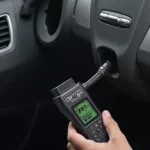The OBD2 code P0161 indicates a problem with the oxygen sensor circuit in Bank 2, Sensor 1 of your vehicle’s engine. This code can be confusing, but understanding its meaning and how to address it can save you time and money. This article will provide a comprehensive guide to P0161, from its causes and symptoms to diagnostic procedures and solutions.
What Does OBD2 Code P0161 Mean?
P0161 specifically refers to a malfunction in the heater circuit of the oxygen sensor. The oxygen sensor, located in the exhaust system, plays a vital role in monitoring the amount of unburnt oxygen in the exhaust gases. This information is sent to the engine control unit (ECU) to adjust the air-fuel mixture for optimal combustion and emissions control. The heater circuit ensures the oxygen sensor reaches its operating temperature quickly, allowing it to provide accurate readings sooner. Bank 2 refers to the side of the engine opposite the cylinder number 1. Sensor 1 is the oxygen sensor located before the catalytic converter. obd2 error code p0161 indicates an issue with this specific sensor’s heater circuit.
Symptoms of OBD2 Code P0161
Recognizing the symptoms of a P0161 code can help you diagnose the issue early. Some common signs include:
- Check Engine Light: The most obvious symptom is the illumination of the check engine light on your dashboard.
- Decreased Fuel Economy: A malfunctioning oxygen sensor can lead to a richer air-fuel mixture, reducing fuel efficiency.
- Rough Idle or Misfires: The engine may idle roughly or experience misfires due to the incorrect air-fuel mixture.
- Failed Emissions Test: A faulty oxygen sensor can cause your vehicle to fail an emissions test.
- Hesitation or Stalling: The engine might hesitate during acceleration or even stall in some cases.
Causes of OBD2 Code P0161
Several factors can contribute to a P0161 code:
- Faulty Oxygen Sensor: The most common cause is a damaged or worn-out oxygen sensor. Over time, the sensor can degrade due to exposure to high temperatures and exhaust gases.
- Damaged Wiring or Connector: Wiring issues, such as frayed wires, corrosion, or a loose connector, can disrupt the heater circuit.
- Blown Fuse: A blown fuse in the oxygen sensor heater circuit can prevent the heater from functioning.
- Faulty ECU: In rare cases, a malfunctioning ECU can incorrectly interpret sensor data or fail to activate the heater circuit.
obd2 scanner codes p0161 helps you pinpoint the exact problem.
Diagnosing OBD2 Code P0161
Here’s a step-by-step guide to diagnosing the P0161 code:
- Retrieve the Code: Use an OBD2 scanner to read the diagnostic trouble codes (DTCs) stored in the ECU.
- Inspect the Wiring and Connector: Visually check the wiring and connector for any signs of damage, corrosion, or loose connections.
- Check the Fuse: Locate and inspect the fuse for the oxygen sensor heater circuit. Replace if necessary.
- Test the Oxygen Sensor: Use a multimeter to test the oxygen sensor’s heater circuit resistance and voltage.
- Test the ECU: If all other components check out, it might be necessary to test the ECU for proper functioning.
“Always start with the simplest and most common causes before moving on to more complex diagnoses,” advises John Smith, a certified automotive technician with over 20 years of experience.
 Inspecting Wiring Harness for Damage
Inspecting Wiring Harness for Damage
Solutions for OBD2 Code P0161
Once you’ve identified the cause, here are some possible solutions:
- Replace the Oxygen Sensor: If the sensor is faulty, replacing it is the most common solution.
- Repair the Wiring or Connector: Repair or replace any damaged wiring or connectors.
- Replace the Fuse: Replace any blown fuses in the oxygen sensor heater circuit.
- Address ECU Issues: If the ECU is faulty, it may need to be repaired or replaced. This is usually a more complex and expensive repair.
solutions for obd2 codes 141 and 161 often overlap, especially if both codes appear simultaneously.
Conclusion
The OBD2 code P0161, indicating a problem with the oxygen sensor heater circuit, should be addressed promptly to avoid further engine issues and ensure optimal fuel economy. By understanding its causes, symptoms, and diagnostic procedures, you can effectively troubleshoot and resolve the problem. obd2 code p0161 ford 2006 f250 5.4l provides more specific information if you own this vehicle. Don’t ignore your check engine light!
FAQ
- Can I drive with a P0161 code? While you can technically drive for a short period, it’s best to address the issue quickly to avoid further damage and reduced fuel efficiency.
- How much does it cost to replace an oxygen sensor? The cost varies depending on the vehicle and the sensor’s location.
- How often should oxygen sensors be replaced? Generally, oxygen sensors should be replaced every 60,000 to 90,000 miles.
- Can a bad oxygen sensor damage my catalytic converter? Yes, a malfunctioning oxygen sensor can eventually damage the catalytic converter.
- Can I replace the oxygen sensor myself? Yes, but it requires some mechanical skills and tools.
- What tools do I need to replace an oxygen sensor? You’ll need an oxygen sensor socket, a ratchet, and potentially penetrating oil.
- How do I clear the P0161 code after the repair? You can clear the code using an OBD2 scanner.
For further assistance, contact us via WhatsApp: +1(641)206-8880, Email: [email protected] or visit us at 789 Elm Street, San Francisco, CA 94102, USA. Our customer support team is available 24/7.

